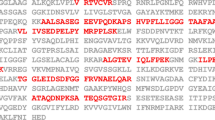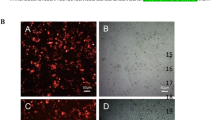Abstract
The E7 oncoprotein encoded by high-risk types of human papillomavirus (HPV) plays a significant role in the development of HPV-related cancers. E7 is a potent stimulator of S phase and host DNA replication. These functions of E7 are linked to the deregulation of the Rb family of proteins. For example, E7 binds and induces proteolysis of Rb through the ubiquitin–proteasome pathway. Despite advances in our understanding of E7, reagents that inhibit E7 with promise in therapy have not been developed or identified. Here, we provide evidence that the tumor suppressor ARF can inhibit E7. We show that the expression of ARF causes a relocalization of E7 from the nucleoplasm to the nucleolus. Two distinct regions in ARF overlapping with the MDM2-binding sites are necessary for the relocalization of E7. Furthermore, we show that ARF blocks the proteolysis of Rb induced by E7. In addition, ARF expression inhibits DNA replication induced by E7. Although it is not known whether the endogenous ARF, which is expressed at a low level, interferes with E7, our results suggest that ARF is an effective inhibitor of E7. We speculate that ARF or an ARF-derived molecule might have a significant impact in therapy against HPV-related tumors.
This is a preview of subscription content, access via your institution
Access options
Subscribe to this journal
Receive 50 print issues and online access
$259.00 per year
only $5.18 per issue
Buy this article
- Purchase on Springer Link
- Instant access to full article PDF
Prices may be subject to local taxes which are calculated during checkout





Similar content being viewed by others
References
Berezutskaya E and Bagchi S . (1997). J. Biol. Chem., 272, 30135–30140.
Berezutskaya E, Morozov A, Raychaudhuri P and Bagchi S . (1997). Cell Growth Differ., 8, 1277–1286.
Bohl J, Hull B and vande Pol SB . (2001). J. Virol., 75, 513–521.
Boyer SN, Wazer DE and Band V . (1996). Cancer Res., 56, 4620–4624.
Chang F, Syrjanen S, Kellokoski J and Syrjanen K . (1991). J. Oral Pathol. Med., 20, 305–317.
Cheng S, Schmidt-Grimminger DC, Murant T, Broker TR and Chow LT . (1995). Genes Dev., 9, 2335–2349.
Datta A, Nag A and Raychaudhuri P . (2002). Mol. Cell. Biol., 22, 8398–8408.
Demers G, Foster S, Halbert C and Galloway D . (1994). Proc. Natl. Acad. Sci. USA, 91, 4382–4386.
Eymin B, Karayan L, Seite P, Brambilla C, Brambilla E, Larsen CJ and Gazzeri S . (2001). Oncogene, 20, 1033–1041.
Flores ER, Allen-Hoffman BL, Lee D and Lambert PF . (2000). J. Virol., 74, 6622–6631.
Funk JO, Waga S, Harry JB, Espling E, Stillman B and Galloway DA . (1997). Genes Dev., 11, 2090–2100.
Halbert C, Demmers G and Galloway D . (1991). J. Virol., 65, 473–478.
Hawley-Nelson P, Vousden KH, Hubbert NL, Lowy DR and Schiller JT . (1989). EMBO J., 8, 3905–3910.
Hickman E, Picksley S and Vousden K . (1994). Oncogene, 9, 2177–2181.
Ishida S, Huang E, Zuzan H, Spang R, Leone G, West M and Nevins JR . (2001). Mol. Cell. Biol., 21, 4684–4699.
Jian Y, Van BA, Chien WM, Shaw GM, Broker TR and Chow LT . (1999). Cell Growth Differ., 10, 101–111.
Jiang M and Milner J . (2002). Oncogene, 21, 6041–6048.
Ko LJ and Prives C . (1996). Genes Dev., 10, 1054–1072.
Korgaonkar C, Zhao L, Modestou M and Quelle DE . (2002). Mol. Cell. Biol., 22, 196–206.
Laimins L . (1993). Infect. Agents Dis., 2, 74–86.
Lohrum MAE, Ashcroft M, Kubbutat MHG and Vousden KH . (2000). Curr. Biol., 10, 539–542.
Martelli F, Hamilton T, Silver DP, Sharpless NE, Bardeesy N, Rokas M, DePinho RA, Livingston DM and Grossman SR . (2001). Proc. Natl. Acad. Sci. USA, 98, 4455–4460.
Morozov A, Shiyanov P, Barr E, Leiden JM and Raychaudhuri P . (1997). J. Virol., 71, 3451–3457.
Munger K, Phelps WC, Bubb V, Howley PM and Schlegel RJ . (1989). J. Virol., 63, 4417–4421.
Nevins JR . (1992). Science, 258, 424–429.
Quelle DE, Zindy F, Ashmun RA and Sherr CJ . (1995). Cell, 83, 993–1000.
Ruesch MN and Laimins LA . (1997). J. Virol., 71, 5570–5578.
Sherr CJ . (1998). Genes Dev., 12, 2984–2991.
Shillitoe EJ, Kamath P and Chen Z . (1994). Cancer Gene Ther., 1, 193–204.
Shillitoe EJ and Steele C . (1992). Ann N.Y. Acad. Sci., 660, 286–287.
Steele C, Sacks PG, Adler-Storthz K and Shillitoe EJ . (1992). Cancer Res., 52, 4706–4711.
Wang J, Sampath A, Raychaudhuri P and Bagchi P . (2001). Oncogene, 20, 4740–4749.
Weber JD, Jeffer JR, Rehg JE, Randle DH, Lozano G, Roussel MF, Sherr CJ and Zambetti GP . (2000a). Genes Dev., 14, 2358–2365.
Weber JD, Kuo ML, Bothner B, DiGiammarino EL, Kriwacki RW, Roussel MF and Sherr CJ . (2000b). Mol. Cell. Biol., 20, 2517–2528.
Weber JD, Taylor LJ, Roussel MF, Sherr CJ and Bar-Sagi D . (1999). Nat. Cell Biol., 1, 20–26.
Wettergreen MA, Hunniford JW, Crawford JM and Adami GR . (2001). Eur. J. Oral Sci., 109, 415–421.
Zatsepina O, Braspenning J, Robberson D, Hajibagheri MAN, Blight KJ, Ely S, Hibma M, Spitkovsky D, Trendelenburg MM, Crawford L and Tommasino M . (1997). Oncogene, 14, 1137–1145.
zur Hausen A and Villiers E . (1994). Annu. Rev. Microbiol., 48, 427–447.
Acknowledgements
This work was supported by grants from NIDCR (DE12506) to SB and NCI (CA76276) to PR. We also thank Dr Jyothish Pilli (University of Chicago) for the inducible E7 cell line.
Author information
Authors and Affiliations
Corresponding author
Rights and permissions
About this article
Cite this article
Pan, W., Datta, A., Adami, G. et al. P19ARF inhibits the functions of the HPV16 E7 oncoprotein. Oncogene 22, 5496–5503 (2003). https://doi.org/10.1038/sj.onc.1206857
Received:
Revised:
Accepted:
Published:
Issue Date:
DOI: https://doi.org/10.1038/sj.onc.1206857
Keywords
This article is cited by
-
ARF promotes accumulation of retinoblastoma protein through inhibition of MDM2
Oncogene (2007)
-
Divorcing ARF and p53: an unsettled case
Nature Reviews Cancer (2006)



